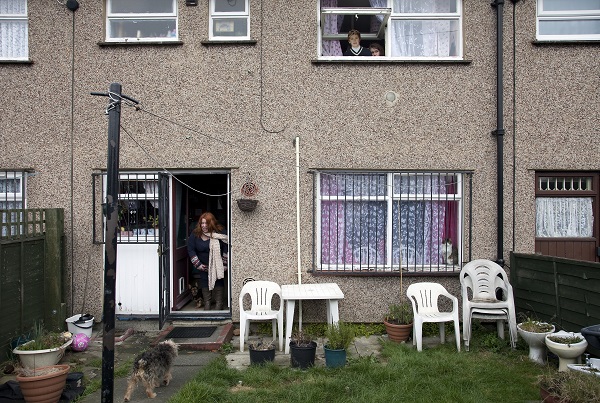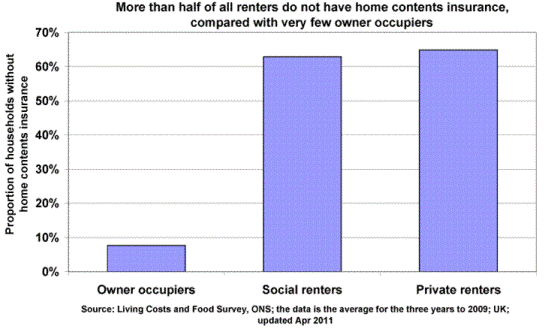Tenants in social or private rented housing: who are we concerned about?
Tenants in social or private rented housing have lower adaptive capacity to flooding and heatwaves

Credit: JRF/Liz Hingley
On this page:
Introduction
Tenants in the social and private rented sectorare likely to have a lower ability to adapt to climate change and extreme weather events compared to home owners. This is partly as a direct result of their living arrangements but also due to the fact that tenants may also have a range of other characteristics, such as lower income levels, which further increase their vulnerability.
However, not all tenants will be equally affected by climate change and extreme weather even when they are exposed to the same event. There are also nuances in relation to the issues across different tenures which need to be understood. It is therefore important to learn about what other characteristics tenants have in the local communities that you are supporting. This is true for all of the vulnerable groups identified in this resource.The Further Resources section provides a link to where you can get more information about who is socially vulnerable and why.
The following shows how tenure can make people particularly vulnerable to climate impacts and related extreme weather.
Flooding
Tenants are not responsible for buildings insurance because this tends to be the responsibility of the property owner. This means they are reliant on their landlord to ensure they live in a building which is appropriately insured and makes it harder for them to take precautions to deal with issues like flood risk which affect their homes.
Tenants are less likely to have home contents insurance compared to owner occupiers. In the UK as a whole, the proportion of households without contents insurance exceeds 60% in the social and private rented sectors (Figure 1), compared to less than 10% in the owner-occupier sector1. Overall, two-thirds of all of the UK households which lack basic contents insurance are occupied by tenants. A number of measures have been put in place to try and improve the take up of insurance cover in the rental sector, such as 'insurance-with-rent' schemes, but these have had limited success2. As a result, tenants are a group who are likely to face particular difficulties replacing any belongings damaged by a flood event.

Figure 1: Contents insurance among owner occupiers, social renters and private renters.3
Tenants are less likely to have the right to change the structure of their property to adapt it to flooding. Thus they are less likely to be able to take advantage of property-level flood resilience measures, and again will be reliant on their landlord for any measures to be in place. There are not enough incentives for developers/landlords to provide additional flood resilience measures. It is the occupiers who may bear most of the cost of flood damage and so developers/ landlords are not motivated to invest in property-level measures.4
Tenants tend to be on low incomes and so may struggle to afford insurance. The rate of poverty among renters is around three times that of homeowners.5 Social tenant households have the lowest incomes of all tenures with a gross annual income of £17,600 in 2011/12. 6 Private tenant households tend to be on a lower gross annual income than homeowners (£30,100 compared to £40,500), yet on average they pay more on weekly rental payments than home-owners do on mortgages (£164 compared to £141). Given that private tenants already spend around 41% of their income on housing (compared to 30% for social renters and 18% for home owners), this presents a considerable financial disincentive for carrying out additional property level adaptations, even if permission is granted from landlords. This situation mayworsenin future given that rates of poverty in the private rented sector are increasing. As of 2011/2 there were almost as many private as social renters in poverty (3.9 million compared to 4.2 million respectively).7 Unemployment rates are also higher for people living in privately rented accommodation; data for 2010-11 shows an unemployment rate of 7% for private renters and 10% for social renters compared to only 1% for owner-occupiers.8
- See the Further Resources section for more information about the specific issues faced by people on low incomes and a set of actions to take in response.
The availability and affordability of insurance is also an issue in some areas where there is a high likelihood of flooding. New government legislation seeks to assist with the provision of affordable insurance to households living in areas of the highest likelihood of flooding under the Flood Re scheme.
- See the Further Resources section for more information about the scheme and issues of flood insurance provision in the UK and more information about why people on low incomes have greater vulnerability.
Private sector tenants may have less local knowledge as they tend to have a shorter length of residence in an area compared to owner occupiers: in 2011-12 32% of private renters had lived in their property less than 1 year, compared to 9% of social renters and 3% of owner occupiers.9
Following flooding, there may be different levels of support for people living in different tenures. Social housing tenants may benefit from support to relocate but may lack control over how this is managed.Indeed, this has been noted as a source of conflict in some situations, for example, evidence from Scotland shows that private tenants and homeowners considered social tenants to have been given preferential treatment in some instances.10 However, social tenants can face the inconvenience and stress of having little control over the timing of the relocation process 11 and the standard of flood repairs being carried out on their homes.
- See the Further Resources section for personal stories about recovering from flooding.
After a flood event, private renters may have problems finding alternative accommodation at a reasonable price due to temporary shortages if demand for short term accommodation increases, including from displaced owner occupiers. Consequently, displacement disrupts their lives and can strain their finances. 12
Heat
Private renters and social tenants are more likely to live in purpose-built flats compared to owner occupiers.These flats are more susceptible to over-heating – see the Adapting Buildings section for information about why. Such flats are much more likely to be occupied by tenants, with 75% of all flats and 81% of all high-rise purpose built flats being within the rented sector. 13 In 2008, some 40% of the UK’s total stock of flats was rented to social tenants and flats made up almost of fifth of all dwellings. 14
Private rented houses, alongside owner-occupied houses, tend to have lower energy ratings (an average 55 SAP rating compared to nearly 63 in the social rented sector). 15 This may mean that they are more prone not only to excess cold but also to overheating. Overheating occurs quickly in poorly insulated homes and is one of the reasons why 1960s top floor flats have overheating problems.
Private tenants on low incomes are less likely to report problems with their standards of housing for fear of eviction.17 Therefore, even though avoidance of excess heat or cold is required through an identified Housing Health and Safety Rating System (HHSRS), this may not be identified without direct action by a local authority.
Private and social renters are more likely to live in overcrowded conditions (6% and 7%respectively) than owner occupiers (1%),18 which increases internal temperatures and may make ventilation more difficult.
As with flooding, tenants are less likely to have the right to change the structure of their property and retrofit their home to be better adapted to high temperatures compared to owner occupiers.
References
- The poverty site. Without home contents insurance.
- Hood, J., Stein, W. and McCann, C. (2009) 'Low Cost Insurance Schemes in Scottish Social Housing: An Empirical Study of Availability and Tenants' Participation', Urban Studies, 46 (9), pp. 1807-1827
- The poverty site. Without home contents insurance.
- Adaptation Sub-Committee (2011) Adapting to climate change in the UK: measuring progress
- McInnes, T. et al, Monitoring Poverty and Social Exclusion 2013
- DCLG (2013) English Housing Survey HOUSEHOLDS 2011-12. Office of National Statistics
- McInnes, T. et al, Monitoring Poverty and Social Exclusion 2013
- DCLG (2013) English Housing Survey HOUSEHOLDS 2011-12. Office of National Statistics
- DCLG (2013) English Housing Survey HOUSEHOLDS 2011-12. Office of National Statistics
- Werritty A, Houston D., Ball T., Tavendale A. & Black A., University of Dundee (2007) for Scottish Executive Exploring the Social Impacts of Flood Risk and Flooding in Scotland
- Werritty A, Houston D., Ball T., Tavendale A. & Black A., University of Dundee (2007) for Scottish Executive Exploring the Social Impacts of Flood Risk and Flooding in Scotland
- Whittle et al. (2010) After the Rain – learning the lessons from flood recovery in Hull, final project report for “Flood, Vulnerability and Urban Resilience: a real-time study of local recovery following the floods of June 2007 in Hull”, Lancaster University, Lancaster UK
- DCLG (2013) English Housing Survey HOUSEHOLDS 2011-12. Office of National Statistics
- DCLG English Housing Survey Housing stock report 2008 page 8
- DCLG (2013) English Housing Survey HOUSEHOLDS 2011-12. Office of National Statistics
- De Santos (2012) A better deal Towards more stable private renting, Shelter.
- DCLG (2013) English Housing Survey HOUSEHOLDS 2011-12. Office of National Statistics

Built by:

© 2014 - Climate Just
Contact us
